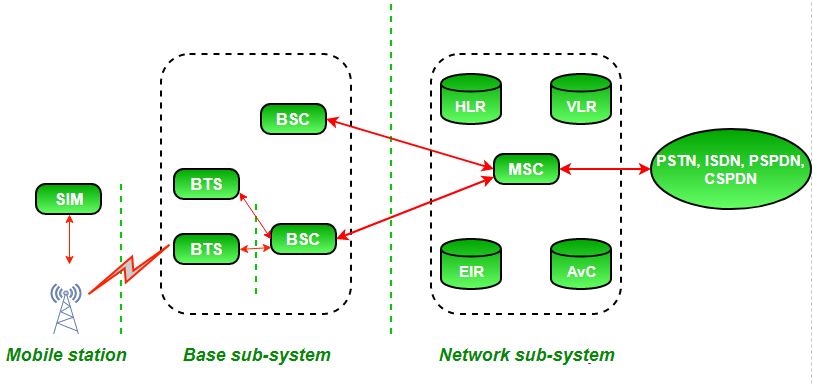The full form of GSM is Global System for Mobile communication.
Introduction – What is GSM?
GSM is a Second-Generation or 2G Mobile Communication System, conceived as a European system in 1991. It is an open and digital cellular technology through which mobile voice and data services can be transmitted. It operates at 850MHz, 900MHz, 1800MHz, and 1900MHz frequency bands.
GSM was designed to enable greater capacity to be achieved than the previous first-generation analog systems by using the digital time division multiple access approaches (TDMA) for the communication process.
This article briefly explains the full form of GSM, its workings, features, advantages, and disadvantages.
The data is reduced and digitalized by the GSM and is sent down through a channel with two different streams of client data in their respective time slot. Data rates from 64 Kbps to 120 Mbps can be transmitted by the digital system.
The TDAM Technique is based on the concept of assigning different timeslots to each user on the same frequency.
GSM Architect
The GSM network constitutes the following components:
- A Mobile Station: It is nothing but a mobile phone which consists of the transceiver, the display, and the processor. It is controlled by a SIM card operating over a network.
- Base Station Subsystem: It acts as an interface between the network subsystem and the mobile station and between the mobile and mobile switching centers. It consists of the Base Transceiver Station, which contains the radio transceivers and handles the protocols for communication with mobiles. The Base Transceiver Station is controlled by the base station controller, a part of the Base station Subsystem.
- Network Subsystem: It consists of:
i). The Mobile Service Switching Centre, which provides access to different networks like ISDN, PSTN, etc.
ii). The Home Location Register and the Visitor Location Register provide the call routing and roaming capabilities of GSM.
iii). The Equipment Identity Register maintains an account of all the mobile equipment wherein each mobile is identified by its IMEI number. IMEI stands for International Mobile Equipment Identity.

Features of GSM Module
- Improved spectrum efficiency
- Compatibility with integrated services digital network (ISDN)
- Support for new services.
- International roaming
- High-quality speech
- Short message service (SMS)
- SIM phonebook management
- Fixed dialing number (FDN)
- Real-time clock with alarm management
- Secured phone calls using encryption
SIM: One important feature that was first implemented on GSM was using a Subscriber Identity Module (SIM). This card contains the users’ identity and other information to allow the user to upgrade a phone very easily while retaining the same identity on the network. It was also used to store information such as “phone book” and other items.
Advantages of GSM
- GSM is used throughout the world. GSM has a harmonized spectrum. Even though different countries may operate on different frequency bands, users can transfer seamlessly between networks keeping the same number. As a result, GSM has a user base in over 218 countries.
- A greater variety of phones are available that operate on GSM. Therefore, consumers have more flexibility in choosing a handset according to their desires from anywhere in the world.
- Users are not charged a roaming fee for international calls because GSM is the same network worldwide.
Disadvantages of GSM
- Interference may be encountered sometimes. With multiple users sharing the same bandwidth, faster technologies, such as 3G, have been developed on different types of networks than CDMA to avoid bandwidth limitations.
- GSM interferes with certain electronic devices, such as pacemakers and hearing aids, because it uses pulse-transmission technology. As a result, many locations such as hospitals and airplanes strongly recommend limiting cell phones.
Conclusion
We hope now you understood the meaning of GSM, the architect of GSM, the features of GSM module, and the advantages and disadvantages of GSM. Still, if you have any doubts or queries, do write them in the comments section below. We would be delighted to help you out at the earliest.

